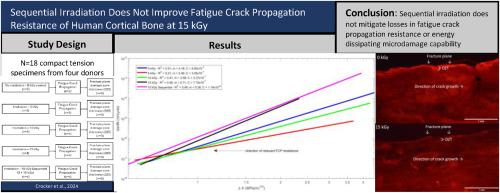Sequential irradiation does not improve fatigue crack propagation resistance of human cortical bone at 15 kGy
IF 3.5
2区 医学
Q2 ENGINEERING, BIOMEDICAL
Journal of the Mechanical Behavior of Biomedical Materials
Pub Date : 2024-11-12
DOI:10.1016/j.jmbbm.2024.106814
引用次数: 0
Abstract
Sequential irradiation has been advocated for mitigating the reduction in fatigue properties of tendon compared to a single dose. However, to our knowledge, its capability of mitigating fatigue losses in bone is unknown. Recently, we reported that sequential irradiation did not mitigate losses in high-cycle S-N fatigue life of cortical bone at 15 kGy; however, it is unclear if sequential irradiation provides a benefit to fatigue crack propagation resistance. Our previous study also showed that radiation-induced collagen chain fragmentation and crosslinking increased from 0 to 15 kGy, suggesting that both likely contribute to the reduction in high-cycle S-N fatigue life within this dose range. Our objectives were: 1) to evaluate the fatigue crack propagation resistance of cortical bone and the effect of radiation on fracture plane damage zone thickness (DZT) at the crack tip in the dose range of 0–15 kGy, and 2) to evaluate whether sequential irradiation at 15 kGy mitigates the loss of fatigue crack propagation resistance of cortical bone compared to a single irradiation dose. Compact tension specimens from four male donor femoral pairs (ages 21–61 years old) were divided into 5 treatment groups (0 kGy, 5 kGy, 10 kGy, 15 kGy, and a 15 kGy sequential irradiation dose of 5 kGy sequentially irradiated with 10 kGy) and subjected to fatigue crack propagation testing (n = 3–4 specimens per group) where fatigue crack growth rate da/dN and cyclic stress intensity factor ΔK were determined. Following testing, specimens were bulk stained in basic fuchsin, embedded in poly(methylmethacrylate), sectioned, and mounted on acrylic slides to evaluate fracture plane DZT at known crack lengths. Sections were then imaged with a fluorescence microscope, and fracture plane DZT was measured using ImageJ (n = 3–4 specimens per group) and analyzed as a function of ΔK. We observed a decrease in fatigue crack propagation resistance at 15 kGy compared to doses of 10 kGy or lower (p ≤ 0.013). Fracture plane DZT decreased overall with increasing radiation dose from 0 to 15 kGy. Sequential irradiation offered no improvement in fatigue crack propagation resistance (p = 0.98). Radiation-induced collagen chain fragmentation and crosslinking in this dose range likely contribute to a decrease in energy dissipation capability with increasing radiation dose. Other alternative radiation sterilization methods besides sequential irradiation may be warranted to mitigate radiation-induced tissue damage and extend the functional lifetime of structural cortical bone allografts.

在 15 kGy 下,连续辐照并不能提高人体皮质骨的抗疲劳裂纹扩展能力。
与单剂量相比,连续辐照可减轻肌腱疲劳特性的降低。然而,据我们所知,它在减轻骨骼疲劳损失方面的能力尚不清楚。最近,我们报道了连续辐照并没有减轻皮质骨在 15 kGy 下高循环 S-N 疲劳寿命的损失;但是,连续辐照是否对抵抗疲劳裂纹扩展有好处还不清楚。我们之前的研究还表明,从 0 到 15 kGy,辐射诱导的胶原链断裂和交联增加,这表明在此剂量范围内,两者都可能导致高循环 S-N 疲劳寿命的降低。我们的目标是1)评估皮质骨的抗疲劳裂纹扩展能力以及在 0-15 kGy 剂量范围内辐射对裂纹顶端断裂面损伤区厚度 (DZT) 的影响;2)评估与单一辐照剂量相比,15 kGy 的连续辐照是否能减轻皮质骨抗疲劳裂纹扩展能力的损失。将四对男性供体股骨(年龄 21-61 岁)的紧密拉伸标本分为 5 个处理组(0 kGy、5 kGy、10 kGy、15 kGy 和 15 kGy 连续辐照剂量,即 5 kGy 连续辐照 10 kGy),并进行疲劳裂纹扩展测试(每组 3-4 个标本),测定疲劳裂纹生长率 da/dN 和循环应力强度因子 ΔK。测试结束后,用碱性品红对试样进行批量染色,嵌入聚甲基丙烯酸甲酯,切片并安装在丙烯酸载玻片上,以评估已知裂纹长度下的断裂面 DZT。然后用荧光显微镜对切片成像,用 ImageJ 测量断裂面 DZT(每组 3-4 个样本),并分析其与ΔK 的函数关系。与 10 kGy 或更低的剂量相比,我们观察到 15 kGy 的疲劳裂纹扩展阻力有所下降(p ≤ 0.013)。从 0 到 15 kGy,随着辐照剂量的增加,断裂面 DZT 整体下降。连续辐照没有改善抗疲劳裂纹扩展能力(p = 0.98)。在这一剂量范围内,辐射引起的胶原链破碎和交联可能会导致能量耗散能力随着辐射剂量的增加而降低。除了连续辐照外,可能还需要其他辐射消毒方法来减轻辐射引起的组织损伤,延长结构性皮质骨异体移植的功能寿命。
本文章由计算机程序翻译,如有差异,请以英文原文为准。
求助全文
约1分钟内获得全文
求助全文
来源期刊

Journal of the Mechanical Behavior of Biomedical Materials
工程技术-材料科学:生物材料
CiteScore
7.20
自引率
7.70%
发文量
505
审稿时长
46 days
期刊介绍:
The Journal of the Mechanical Behavior of Biomedical Materials is concerned with the mechanical deformation, damage and failure under applied forces, of biological material (at the tissue, cellular and molecular levels) and of biomaterials, i.e. those materials which are designed to mimic or replace biological materials.
The primary focus of the journal is the synthesis of materials science, biology, and medical and dental science. Reports of fundamental scientific investigations are welcome, as are articles concerned with the practical application of materials in medical devices. Both experimental and theoretical work is of interest; theoretical papers will normally include comparison of predictions with experimental data, though we recognize that this may not always be appropriate. The journal also publishes technical notes concerned with emerging experimental or theoretical techniques, letters to the editor and, by invitation, review articles and papers describing existing techniques for the benefit of an interdisciplinary readership.
 求助内容:
求助内容: 应助结果提醒方式:
应助结果提醒方式:


